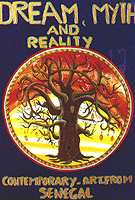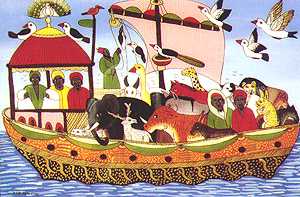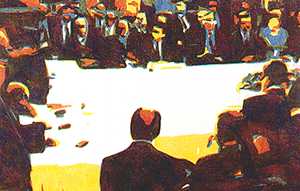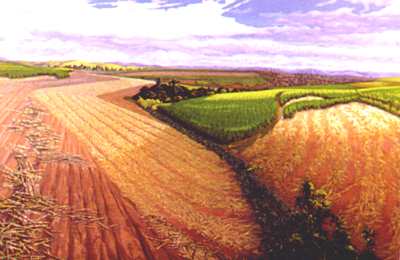| About the Arts | U.S.A. | ||||||||||||||||||||||||||||||||||||||||||||||
BAFA © 2010. All material here is copyrighted. See conditions above. |
Mona Khademi
arts manager / administrator, U.S.A.
|

Painting by Jawad Al-Malhi
From the exhibition: "Building Bridges: Israeli and Palestinian Artists Speak". Photo: Courtesy of Meridan International Center. |
The Arts as Pathways to Global Unity
He believed that artistic experience enlarges and refines our "repertory of feeling." ...Art is one of the world's greatest unifiers, it transcends cultural barriers and serves as a creative means of communication that helps people better understand other cultures. Art reminds us of our common humanity. Bahá'u'lláh, wrote that The source of crafts, sciences, and arts is the power of reflection. Make ye every effort that out of this ideal mine there may gleam forth such pearls of wisdom and utterance as will promote the well-being and harmony of all the kindreds of the earth. (Tablets of Bahá'u'lláh , Comp., 72.) |
.....How can this sense of common identity be reinforced
throughout the world? One way is through international exchange programs
that make the arts available across borders. As countries become increasingly
interdependent, they need to foster the study of other cultures to ensure
that their citizens learn not only to tolerate their neighbors but also
to appreciate their differences. Cultural and arts exchange programs
are especially needed in countries characterized by racial, ethnic,
and cultural diversity.... |
 BAOBAB, 1992, Reverse Glass Painting, by Mor Mueye. From the exhibition: "Dream, Myth and Reality: Contemporary Art From Senegal". Photo: Courtesy of Meridan International Center. |
Here I will
give examples from three major exhibitions that were held in Washington,
D.C. between 1990 and 1997 and which then traveled to major cities. The
exhibitions were: Dream, Myth and Reality: Contemporary Art from
Senegal; Building Bridges: Israeli and Palestinian Artists
Speak; and Panoramas of Passage: Changing Landscapes of
South Africa. |
The press release for this exhibition stated,
"Although the works represent a wide variety of styles and show some Islamic and Christian influences,
all are African at the core."
|

Arche de Noe (Noah's Arch), 1992, Reverse Glass Painting, by Mor Mueye. From the exhibition: "Dream, Myth and Reality: Contemporary Art From Senegal". Photo: Courtesy of Meridan International Center. |
Senegalese history, myths, customs and beliefs are expressed by the artists in characteristic designs and vibrant colors,
evoking
"those of the sunsets, the sea, the countryside, [and] the fabrics worn by Senegalese men and women as they go
about their daily lives."
|

Analogic Painting Madrid Conference 1991, by Arnon Ben David From the exhibition: "Building Bridges: Israeli and Palestinian Artists Speak". Photo: Courtesy of Meridan International Center. |
2. Building Bridges: Israeli and Palestinian Artists Speak:
|
Some of the works related to religious themes and some were political, but most of the work was highly abstract. Fifteen years after they began, the twelve artists continue to exhibit together, sometimes even to paint on the same canvas....
|
The exhibit was complemented by a variety of cultural programs, including a concert series, a
film on Jerusalem, a storyteller, interactive performances by a dance group, an "Evening of Poetry" and visits to the
exhibition. Eight of the twelve artists participating in Building Bridges came to the U.S. for the opening and
gave several presentations to different audiences. The exhibition provided a framework for organizations at each
venue to design special educational and cultural programs. These included an exhibition of children's art,
"Peace Around the World for the Holidays"; a singing performance at the museum by children's groups from a
synagogue, a mosque and local Catholic and Protestant churches; a lecture on the exhibition by the museum's chief curator;
and a panel discussion entitled "Islam, Christianity and Judaism."
3. Panoramas of Passage: Changing Landscapes of South Africa
|
 Cane Cutting, Eshowe District, 1990, by Diamond Bozas. Collection: Durham Art Gallery, South Africa. From the exhibition: "Panaromas of Passage: Changing Landscapes of South Africa". Photo: Courtesy of Meridan International Center. |
The project began just before the 1994 free elections in that country.
|
...The collaboration of Israeli/Palestinian artists influenced the opinions of people who saw the exhibition and participated in the ancillary activities about the conflict in the Middle East. Seeing and hearing both sides of the issue brought focus and clarified some misunderstandings among the two groups...
...As evidence of the show's success, Jewish and Palestinian communities came together both during and after the exhibition.
... ...Talks, conferences, and seminars organized by the leaders of the two communities have continued since the
exhibition.
The South African exhibition, to cite another example, attracted blacks, whites, and interracial school groups when it
was shown in Washington, D.C. and on tour. The tour leaders explained the positive steps that have been taken by the
South African community and how difficult it has been to establish peace and change prevailing opinions. Comparisons
were made with racial issues in the U.S. The experience, thus, helped to increase understanding of race relations.
The creativity of Senegalese art served as a reminder of the rich contribution that African culture makes in an
increasingly global culture...
Excerpt from Arts Dialogue, October 2000, Arts Dialogue. pages 17 - 19
|
For further information:
www.arts-management.com
Contact Mona Khademi at: ArtsManagement@aol.com |
|
Arts Dialogue, Dintel 20, NL 7333 MC, Apeldoorn, The Netherlands email: bafa@bahai-library.com |